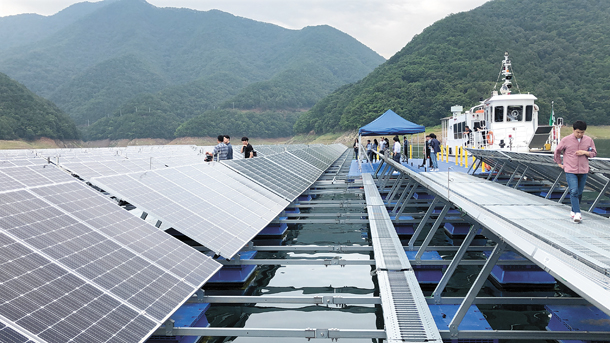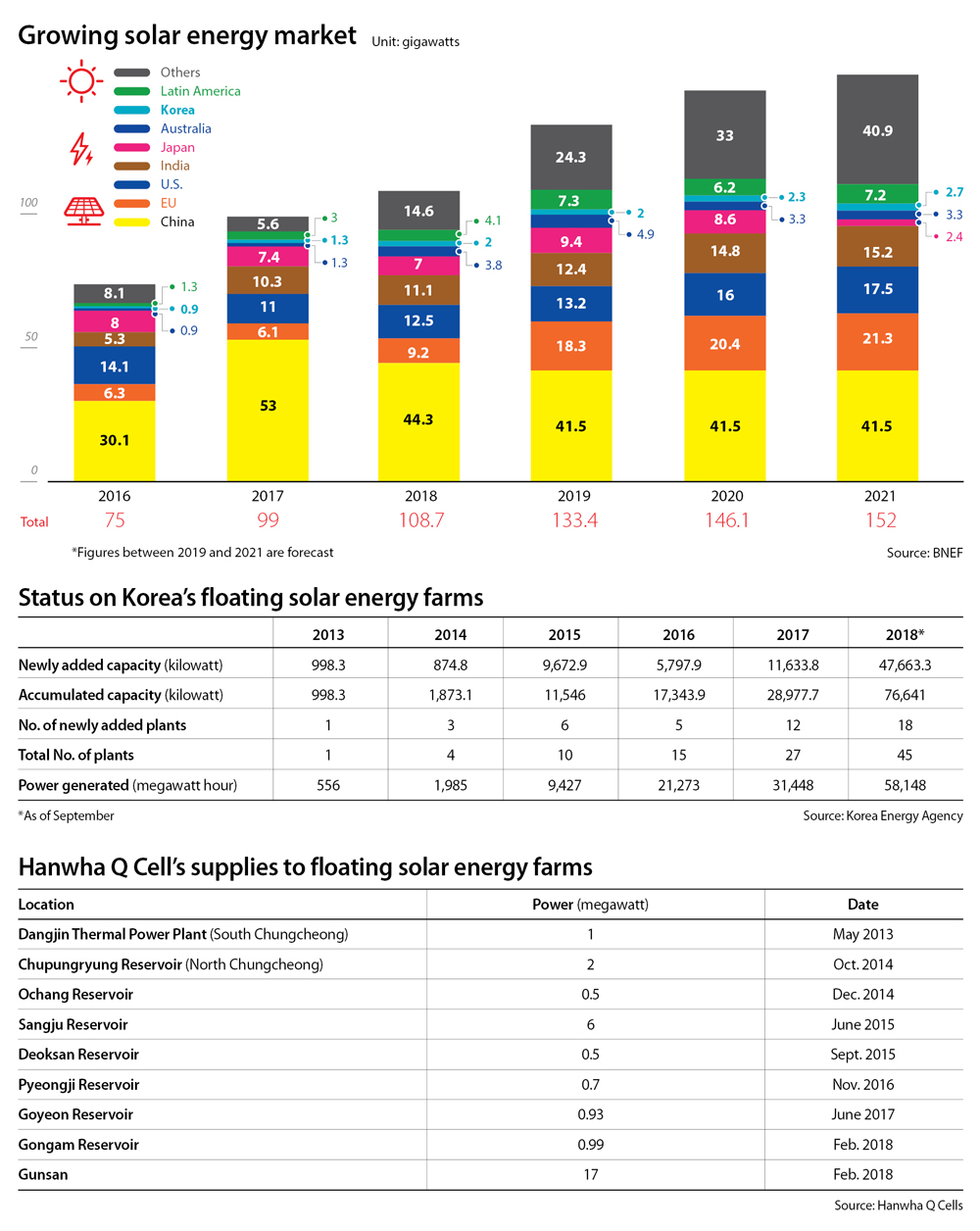Floating farms offer solar power solution

The overview of the floating solar power farm on Cheongpung Lake. [LEE HO-JEONG]
Despite the earlier weather forecast of a downpour in the region, it only drizzled lightly for a brief period, adding to the tranquility of the floating solar power plant, which was surrounded by nothing but mountains.
It felt as though even a whisper could break the serene scene.
“[The floating solar power plant] is located 17 kilometers (10.6 miles) away from Chungju Dam where our staff [that manages the farm] works, which makes maintenance inconvenient,” said Joo In-ho, the general manager of the floating photovoltaic business at the state-owned water resource management agency K-water. “However, we set up the farm because of a remote village of seven houses that’s only 3 to 4 kilometers away.” Joo added, “By installing the floating solar power farm, the village has been supplied with electricity for the first time.”
He added that with the installation of the power farm, a new road was constructed that shortened the traveling distance to the remote village by 30 minutes.
The floating solar power plant is made of 8,812 photovoltaic modules - each measuring 1 meter in length and 1.96 meter in height - and covers a 39,600 square-meter area of the lake.
K-water invested 8.4 billion won ($6.9 million) in the project that took 10 months to complete.
The power plant opened in December 2017 and has a 3-megawatt capacity that generates 4,031 megawatt hours of power a year. That translates to a year-long supply of electricity for 1,000 households.
It was the largest floating solar power plant on the peninsula, before it handed the title over to Gunsan in November 2018. The Gunsan floating solar power plant, which covers a 204,940 square-meter area, has an 18.7 megawatt capacity with 25,322 megawatt hours of power supplied a year. Simply put, the Gunsan power plant supplies enough electricity to sustain 7,450 houses a year.
Since President Moon Jae-in announced the phase out of nuclear energy early into his administration, the current Korean government has set the goal of raising the contribution of renewable energy, which was 7.6 percent in 2017, to 20 percent by 2030 and to 35 percent by 2040.
President Moon has shown particular interest in floating solar power farms. After visiting Gunsan in October 2018, he announced the world’s largest floating solar power farm would be created on Saemangeum, an estuarine tidal flat on the west coast of the peninsula.
“The renewable energy business at Saemangeum will be a groundbreaking turning point that will raise our renewable energy industry’s competitiveness to the level of the world,” President Moon said during a speech he made standing in front of solar panels at Saemangeum, Gunsan, North Jeolla, “It is a healthy energy that protects the public’s safety and a new growth engine that will open our future.”
President Moon pointed out the rapid growth of renewable energy in the global market adding that renewable energy in China alone accounted for more than 25 percent of its energy sources.
“Last year ours only accounted for 8 percent,” Moon said. “And more than half was [generated by] waste power generators,” Moon added. “[Our government] will raise the contribution of renewable energy to 20 percent by 2030.”
In July, the Korean Ministry of Trade, Industry and Energy approved the 4.6 trillion won plan for the Saemangeum floating solar farm, which once completed in 2025 will have a 2.1 gigawatt capacity.
The farm will cover a 30 square-kilometer area and generate 2,759 gigawatt hours a year, enough to power roughly 1 million households.

The government estimates the solar power farm will generate an economic effect of 25 trillion won over 10 years.
But Korea isn’t the only country vying to create the world’s largest floating solar power farm.
The Netherlands earlier this year laid out plans to install the world’s-largest floating solar power plant on its North Sea, 15 kilometers off Scheveningen. The plant plans to install 2,500 solar panels by 2021.
The market for floating solar power farms is rapidly growing.
According to a 2019 World Bank report, the global capacity of floating photovoltaics has been growing at an exponential rate, especially in the last four years.
The accumulated floating solar farm capacity has surged from 11 megawatts to 1,314 megawatts from 300 floating solar power farms globally as of last year. Last year alone 786 megawatts of photovoltaic capacity was added.
China currently leads with 950 megawatts, which accounts for 73 percent of the world’s capacity, while Japan trails behind with 208 megawatts or 16 percent. Korea takes third place with 75 megawatts or 6 percent.
Floating solar power farms are a great option for Korea, which has limited space.
“Sixty-four percent of the land in Korea is forest,” said Joo, the general manager at K-water. Joo said to install a power farm with 3-megawatt capacity, a 37,000 square-meter area is needed. “We can’t just cut down trees to install solar power plants.”
According to a World Bank report, installing a solar power farm on just 1 percent of the world’s reservoir surface, could secure a 404 gigawatt capacity and could replace 404 1-gigawatt thermal power plants.
It could also generate roughly 521 terawatt hours, the equivalent to 15 percent of all power consumed in Europe in 2018.
It is also almost equivalent to Korea’s own electricity consumption, which last year amounted to 565 terawatt hours. Korea is ranked the world’s sixth when it comes to electricity consumption.
Another advantage of solar power farms built over water to those on land is the improvement in efficiency.
“The solar modules in Korea are made of crystalline silicon, of which quartz is the raw material” said Joo. “The biggest influence to this module, which has a standard test condition of 25 degrees Celsius, is temperature.”
The K-water official said contrary to common belief, higher temperatures do not translate to larger outputs. In fact it is the opposite. When the temperature rises above 25 degree Celsius, photovoltaic modules output actually drops.
It is estimated that every 1 degree Celsius the temperature rises after 25 degrees Celsius leads to a 0.5 percent output efficiency drop.
“But here, on average the temperature remains around 26 degrees Celsius,” Joo said. “During summer, the power output is larger than anywhere else.”
Korean companies, like Hanwha Q Cells, are already aggressively seeking to win major floating solar power farm projects including Saemangeum.
The company is reportedly preparing to not only sell its modules, but also expand its participation including designing the farm and constructing it. Major competition includes Hyundai Energy Solutions, an affiliate of Hyundai Heavy Industries.

The ground-level view of the floating solar power farm on Cheongpung Lake on Thursday last week. [HANWAH Q CELLS]
Hanwha Q Cells has become a major new growth engine for Hanwha Group.
The company, which was founded in 2004 as Solarfun Power Holdings, later expanded by acquiring Germany’s Q Cells in 2012, which helped it to become the world’s third-largest solar energy company.
Hanwha Q Cells is further expanding its business in global floating solar power plants.
The Korean company in June last year supplied 6,100 300-watt monocrystalline photovoltaic modules to the Netherland’s largest floating solar power farm at a reservoir near Lingewaard.
The floating power farm which covers a 15,800 square-meter area of the reservoir generates 1,800 megawatt hours that supplies power to 400 households.
“If floating solar power plants are gradually installed on 1 percent of the world’s reservoirs, based on the current construction cost, a global market of more than 500 trillion won will be opened,” said Jerry Yu, vice president at Hanwha Q Cells. “If Korean companies build up experience from local projects, floating solar power plants will become Korea’s new growth engine.”
IBK Securities analyst Ham Hyung-do said Hanwha Q Cells is one of the few companies that have the technology on monocrystalline silicon cells.
“Korea could only succeed in photovoltaic module because the components are the same as semiconductor chips but the process is less than that of semiconductors,” Jeong Jae-seong, senior researcher at Korea Electronics Technology Institute said. “And since Korea is the world’s No. 1 in semiconductors, naturally Korea also excels in this field.”
According to K-water’s Joo, foreign countries especially countries like Indonesia and Vietnam that have huge body of waters are taking interest in Korea’s floating solar power plants.
“They are the most frequent visitors to our plant on Cheongpung Lake,” Joo said. “These are countries that have an abundance of water resources but struggle with supplying electricity due to the lack of power grids.”
However, Professor Roh Tae-ho, chief researcher at Korea Environment Institute said while their studies of floating solar power farms have not shown any environmental damages or concerns, the institute has not yet conducted any studies on floating power plants on open water.
BY LEE HO-JEONG [lee.hojeong@joongang.co.kr]










with the Korea JoongAng Daily
To write comments, please log in to one of the accounts.
Standards Board Policy (0/250자)